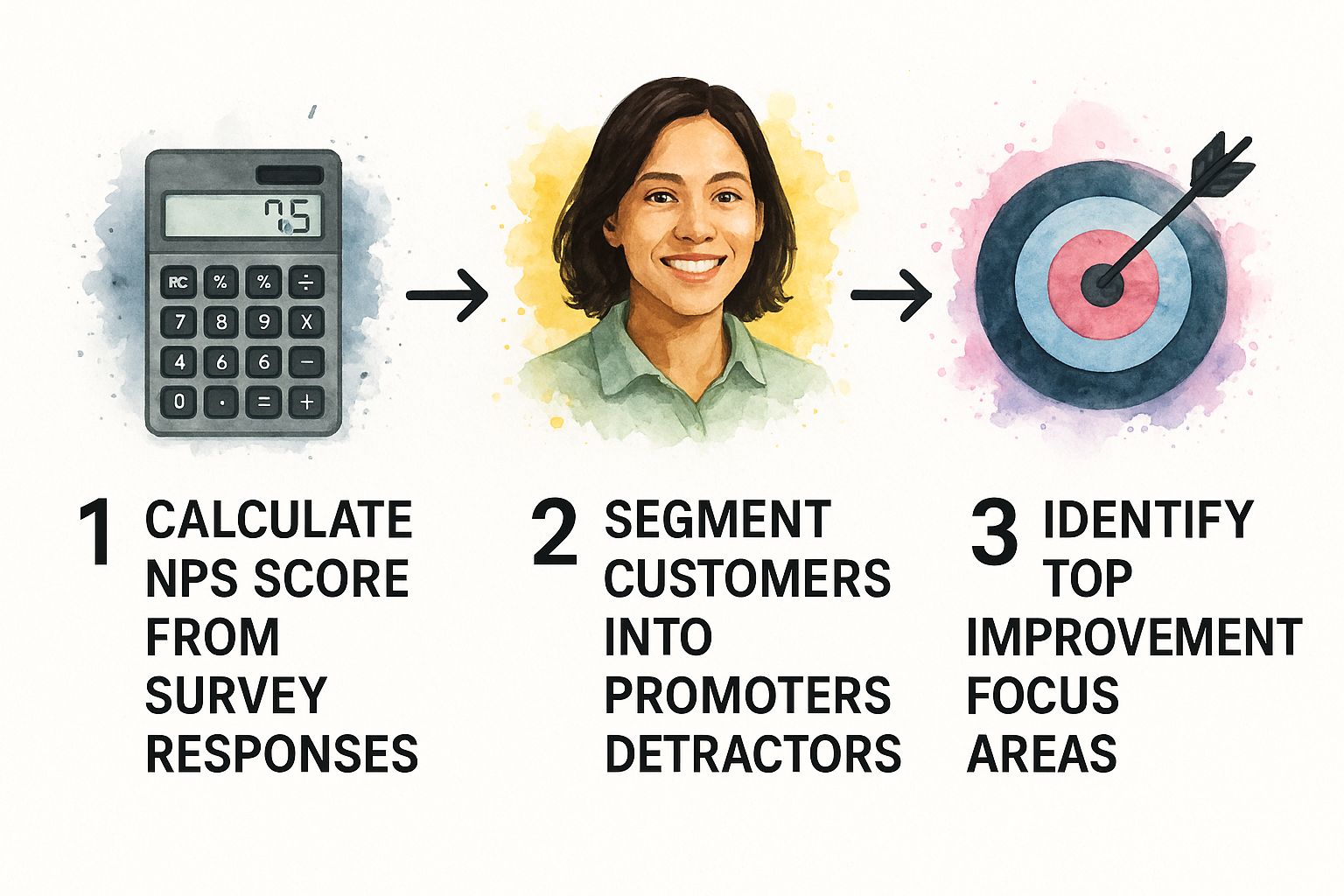Your NPS Score Is a Useless Vanity Metric (And You're Probably Wasting Time On It)
Tired of vanity metrics? Learn how to improve NPS by analyzing feedback that actually drives growth. Practical, founder-tested strategies for real results.
Posted by
Related reading
Stop Listening to Your Customers
Learn what is natural language processing and how it unlocks real voice-of-customer insights. A no-BS guide for founders tired of guessing.
Stop Guessing. Your Customers Are Lying to You.
Discover effective customer satisfaction measurement techniques to improve your business. Learn proven methods to gauge and enhance customer happiness.
Stop Guessing. These Are the Only Customer Satisfaction Measurement Methods That Matter.
Discover effective customer satisfaction measurement methods to improve your business. Learn the top techniques for accurate insights today!
Let's be honest. You’re obsessed with your NPS score. You celebrate a 2-point jump and panic over a 3-point drop. Meanwhile, your customers are screaming the answers to your biggest growth problems in that little text box you never read.
I almost tanked an early feature launch because my team and I were so focused on the number that we were deaf to what people were actually saying. We were addicted to the score like a high score in a video game, patting ourselves on the back while users were churning out the back door.
The score tells you that there's a fire. The comments tell you where it is and what to pour water on. Stop staring at the smoke and find the flames.
Ignore Your Customers, and You'll Be Lucky to Survive the Quarter
Chasing a higher score without understanding the "why" is like trying to get fit by only looking at the scale. The number might change, but you have no clue if you’re gaining muscle or a tumor. You’re flying blind, making decisions based on ego, not evidence.
The hilarious part? When you stop chasing the score and fixate on the feedback, the score goes up on its own. And that score does have a very real connection to your company's health.
Data shows companies that actually improve their NPS see revenue grow 70%, while those with a declining score get slapped with a 24% drop. It's not magic. NPS leaders outgrow their rivals by more than double. Learn more about the financial impact of NPS.
Ignoring the verbatims isn't just a bad habit; it's a direct path to burning cash. Your customers are handing you a free roadmap to a better product. All you have to do is read it. Your job isn't Chief Score Watcher. It's Chief Mining Officer—digging for gold in the dirt of customer complaints.
This guide isn’t another fluffy blog post telling you to "listen to your customers." It’s a punch in the gut to fix your broken process.
Takeaway: The score is a signal, not the prize. The prize is in the comments.
Stop Sending Polite Surveys—Build a Feedback Engine

Your current feedback "process" is probably a sterile, polite survey. It’s a corporate ritual, not an intelligence-gathering operation. You send a generic form, get a number, and file it in a spreadsheet to die.
You've built a museum of old data, not a factory for improvement. A real feedback system has a pulse. It’s an engine fueled by raw, unfiltered truth, not polite nods. You can't get that by sending the same survey to a power user who just hit a bug and a new user who can't find the login button.
Your Follow-Up Questions Are a Scalpel, Not a Sledgehammer
The 0-10 score is just the ticket to the game. The real action is in the follow-up question. This is where 99% of founders drop the ball with a lazy, generic, “Care to explain your score?”
Stop it. Be a surgeon.
For Detractors (0-6): Don't ask why. Ask what their single biggest disappointment was. "Disappointment" cuts through the noise. It forces them to pinpoint the exact moment your product broke its promise.
For Passives (7-8): They’re on the fence. Don't ask for vague feedback. Ask: “What’s the one thing we could do that would make you use our product every day?” This is a targeted hunt for the sticky feature that turns apathy into addiction.
For Promoters (9-10): They love you. Don't just thank them—interrogate them. Ask: “What do you love most about us that you think other people miss?” This is how you find your hidden genius and get free marketing copy from your best customers.
This isn’t just about collecting better data; it’s about showing you give a damn. Specific questions get specific answers. For more on this, read our no-BS guide on how to get customer feedback.
Automate the Process, Not the Relationship
Your goal is to make every single customer—especially the pissed-off ones—feel like their feedback landed directly on your desk, not in a digital black hole. A Detractor who flags a bug shouldn’t get a canned “Thanks for your feedback!” They should get a reply that says, “Ouch. That sounds awful. A support ticket has just been opened for this.”
This is about building an engine that collects, segments, and routes feedback intelligently. Promoters get funneled to your marketing team for testimonials. Detractors reporting bugs go straight into the engineering queue. Passives asking for features get routed to your product backlog.
Takeaway: Stop running surveys. Start building a feedback factory that turns raw opinions into your sharpest weapon.
How to Analyze Feedback Without Losing Your Mind (and Your Will to Live)
You have a spreadsheet with 1,000 raw customer comments staring back at you. Now what?
This is where most founders fumble. They either get analysis paralysis and ignore the file, or they hand it to an intern who makes a pretty but useless word cloud. Both are guaranteed paths to staying exactly where you are. You don't need a 50-page report. You need a three-bullet-point summary for your next meeting: “Here’s what’s bleeding, here’s what’s working, and here’s the opportunity we’re missing.”
Ditch the Word Cloud. Start Bucketing.
First rule of feedback analysis: word clouds are for designers, not founders. They are the business equivalent of a mood ring—they look pretty but tell you nothing. “Users are saying ‘feature’ a lot!” No shit.
Your job is to be a triage surgeon, not a poet. You need to sort the chaos into buckets that demand action. This isn't complex. You can learn how to turn data into actionable insights in about ten minutes.
Every comment you get falls into one of these four piles:
- Product Gaps: "I wish you had an X integration." This is your future roadmap, handed to you for free.
- Bugs & UX Friction: "The 'save' button is broken on mobile." These are the paper cuts killing your user experience. Stop the bleeding.
- Pricing & Billing Issues: "This is way too expensive." This is a direct signal about your value proposition. Ignore it at your peril.
- "Wow" Moments: "Your support team is ridiculously fast." This is pure gold. It’s your marketing copy, your core strength, and the thing you must never, ever break.
This simple process transforms a spreadsheet from a graveyard into a battle plan. The infographic below shows the flow. The score is just the entry point.

The score segments the user. The comment tells you what to build, fix, or double down on.
A Founder's Feedback Triage Framework
Use this to rip through comments without getting lost.
| Category | What It Means | Action To Take |
|---|---|---|
| Bugs | It's broken. Users are blocked. | PING ENGINEERING. Prioritize by how many people are screaming. |
| Feature Requests | They want something you don't have. | LOG IN PRODUCT BACKLOG. Prioritize by strategic fit, not by who yells loudest. |
| UX Friction | It works, but it's a pain in the ass. | SEND TO PRODUCT/DESIGN. Fix these small annoyances to stop churn. |
| Compliments | You found a "wow" moment. | SHARE WITH THE TEAM. Double down on this in your marketing. NOW. |
This isn't rocket science. It's a system to keep you focused on action, not analysis.
Graduate From Spreadsheets to Sanity
Manual bucketing is great. Do it for your first 100 responses. Get a feel for the raw pain and joy. Then stop. Your time is worth more than that.
This is where you graduate. You need a system that does the grunt work. Your goal is to automate the analysis, not your understanding. A machine should sift through 1,000 comments to find the patterns, so you can spend your time deciding what to do about the three big themes it uncovers.
You can duct-tape a solution with Zapier, but you'll outgrow it. When you're ready to get serious, check out specialized customer feedback analysis tools that do the heavy lifting.
Takeaway: Stop reading every comment and start spotting every pattern. Your job is strategy, not data entry.
Closing the Loop Is Action, Not Acknowledgment

"We've passed your feedback to the team." That sentence is the biggest lie in business. It’s the corporate version of “I’ll call you,” and everyone knows their idea is heading straight for a digital shredder.
These emails are worse than silence. They're a sign of disrespect.
Closing the loop isn't telling a customer you heard them. It’s showing them you listened by shipping something. If your feedback process ends with an automated reply, you haven't closed a loop—you've slammed a door in your customer's face. This is where legendary companies are built.
Build a Public "Feedback-to-Feature" Pipeline
Stop hiding your work. Your customers deserve to see the sausage being made. Use a public roadmap or feedback portal. It’s not an internal Jira board; it's a living, breathing promise to your users.
A simple, deadly effective setup:
- Track Suggestions Publicly: Use a tool like Canny or a public Trello board. This proves you’re not just nodding along.
- Announce What You're Building: When a suggestion gets the green light, move it to "In Progress." This builds insane hype and loyalty.
- Be Honest About What You’re Not Building: This is the gutsiest move. If an idea sucks or doesn't fit, mark it as "Not Planned" and explain why. People respect brutal honesty far more than ghosting.
This transparency holds you accountable and turns customers into co-builders. They become invested because they see their fingerprints all over your product.
Turn Your Biggest Critics Into Raving Fans
Here’s the fun part. When you ship that feature or fix that bug, don't just tweet about it. Go back to the source.
I once had 50 Detractors all screaming about our clunky export feature. When we fixed it, we didn't send a marketing blast. We emailed every single one of those 50 people personally.
The message: "Hey [Name], you told us our export feature sucked. You were right. We just fixed it because you told us to. Check it out and let us know if we nailed it."
The result? Over half of those Detractors became Promoters within a month. We didn't just fix a bug; we showed them their complaints have power. That’s how you build a moat around your business.
Takeaway: Fixing the product is half the job; telling the people who complained is the other, more important half.
Turn Your Promoters Into an Unpaid Sales Team

Your Promoters—the 9s and 10s—are the most valuable and wasted asset you have. Most founders send a "thank you" email and move on, while their marketing department burns cash trying to find new customers who look exactly like them.
This is a catastrophic mistake. Your Promoters aren't a feel-good metric. They are a volunteer army waiting for orders. Your job is to arm them.
Give Them a Mission, Not a Button
A "share with a friend" button is lazy and ineffective. Give them specific, high-impact missions.
A simple playbook that prints money:
The Testimonial Ambush: The second they give you a high score, pounce. "That’s amazing to hear! Mind if we use that as a testimonial? We'd love to feature you." It’s direct, flattering, and has a clear call to action.
The Case Study Hunt: A Promoter leaves a detailed comment about how you saved them 10 hours a week? That's not feedback, that's a case study begging to be written. Reach out personally and offer to feature their story.
The Referral Machine: Build a dead-simple, win-win referral program. "Give a friend 20% off, get a $50 credit." No complicated rules. Powerful customer referral programs turn your best customers into your best salespeople.
Market Leaders Weaponize Their Fans
Activating promoters is what separates good companies from dominant ones. Average companies hover around a 30-50 NPS. Market leaders like Apple and Tesla are consistently above 70. That's not a vanity score; it's a reflection of a fan base so loyal they do the marketing for them.
Managing this requires a system. Using one of the best customer feedback tools is how you automate identifying and activating your biggest fans at scale.
Takeaway: A Promoter isn't a number. They're a potential blog post, a five-star review, or your next big customer—just waiting for you to ask.
Stop Guessing and Start Growing
You have the playbook. Now you need the engine.
Wrestling with spreadsheets and guessing what your customers really mean is a losing game. It’s slow, it’s stupid, and your competitors who move faster will eat your lunch. It's time to stop guessing and get real answers from your feedback—the kind that actually build a better product and a bigger business.
A plan is useless without the tools to execute it.
Stop drowning in spreadsheets and start getting the damn answers from your customer feedback with Backsy.